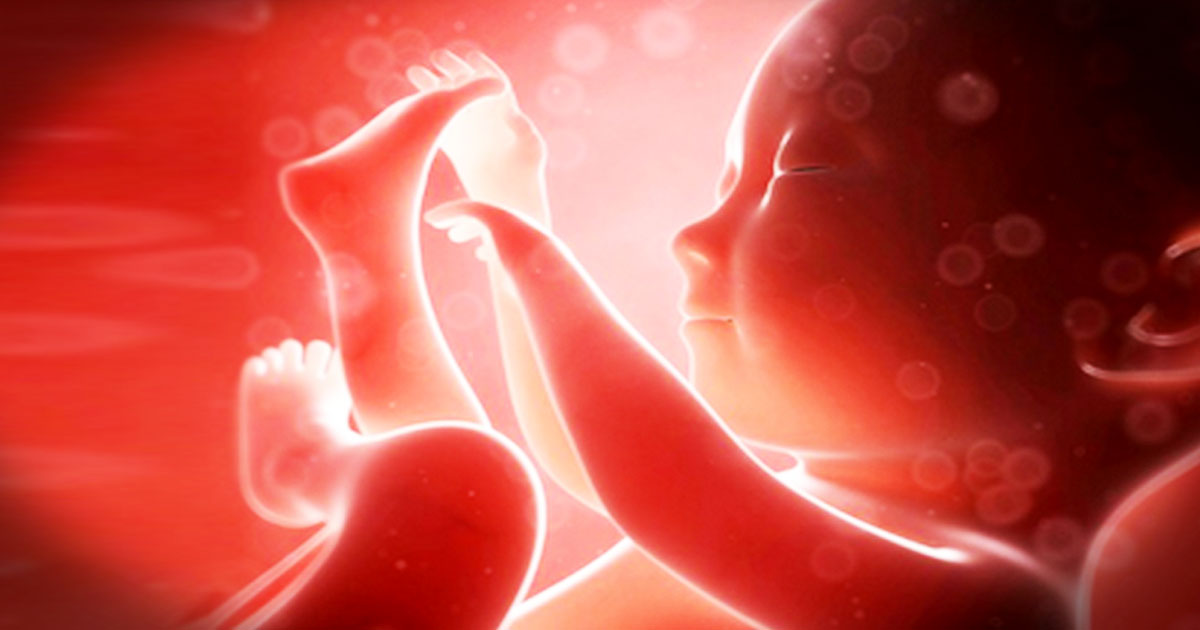There are a countless number of babies who are snatched from their mommy’s wombs without a chance to fight for their right to life. So many people are wounded in abortion, not just the babies, but also the mothers, and when you read this story, you’ll know it’s hurting the doctors and nurses, too.

Credit: Thinkstock
Although such a terrible thing exists, we must never forget about the love and power of Jesus Christ. Our precious aborted babies are now safe in His loving arms, and He has the power to change the hearts and minds of the mothers, doctors, and nurses that perform them. And this is exactly what He did for Nurse Bonnie L. McClory who worked in a large metropolitan hospital that performed abortions.
Bonnie worked as a student obstetric technician (OB tech) in the Labor and Delivery unit while she pursued her nursing degree. Her ultimate goal was to assist in delivering babies.
One would think that working on a hospital’s delivery floor would be full of excitement and anticipation. This wasn’t the case for Bonnie; some of the babies that she helped deliver were alive, and others lives were ended before having the chance to take their first breath. These babies were the victims of late-term saline abortions administered to them at the hospital.
During a saline abortion, a needle is stuck in the pregnant woman’s abdomen. The precious baby is poisoned, burned, and dies several hours later. After the baby dies the mother’s labor is induced and she delivers a lifeless child.
From the beginning, Bonnie appeared to be the only nursing student in her class who seemed to have a tender heart towards the unborn babies. Something from her own past moved her more than her classmates would ever know.

Credit: Thinkstock
Bonnie tells her story:
“My status in the class was one of the maverick. I was staunchly pro-life; my views arose from my own experience of being unintentionally pregnant at 17 and a mother at 18. None of my classmates had ever borne a child; only one was married. I had already given birth to two sons and had seen my marriage disintegrate.
My classmates did not seem too affected by our having to watch a first-trimester abortion from the operating room gallery as part of our training. I sat among them, tears staining my white scrub dress; they chatted about the handsome resident doing the procedure and how lucky the teenage patient was to be able to get on with her life. I fought nausea as I watch that handsome resident piece together what he and removed from the teenager’s uterus as he made sure he got it all out. My classmates turned away from the sight of the little mound of red flesh laid out in the small metal basin. They turned away from my obvious grief, as well.”
Bonnie's classmates’ cold-hearted attitudes filled her with so much sorrow. Later, she and the other OB techs in the class were the were given the assignment of assisting with saline abortions:
“We OB techs were supposed to provide the supportive care to these [saline] patients while they labored and assist the doctor when he or she delivered the dead fetus. None of my OB Tech colleagues like this part of the job. I heard them rationalize it, though, as a woman’s right to choose.
But it broke my heart, every time the doctor handed me a basin with a small, perfectly formed human baby lying dead and bloody inside it. I forced myself to rationalize that I had done nothing to bring about this death; I was merely cleaning up the after effects. That way, I could live with myself…”
The more abortions that Bonnie was required to attend, the more her conscience ate her alive:
Saline abortions became more and more frequent in the Labor and Delivery Unit. In an effort to cope, I read about the procedure, hoping against hope that it was not as horrible as my mind imagined it to be. It wasn’t – it was worse.

Credit: Thinkstock
Bonnie witnessed terrible things in the delivery room. She was heartbroken when patients would ask about the sex of their aborted fetus. She was devastated when she had to tend to the tiny broken bodies after the ‘procedure.’
You see, it was Bonnie’s job to prepare the babies’ bodies "to be sent to the lab where they would be used for study and dissected. "
Cleaning up meant boxing up the fetus in a round, white, one gallon cardboard container – the kind you see in ice cream stores.
Bonnie hated this part of her job, but she managed to find a way to cope through the pain by rationalizing her role. But one day Bonnie reached her breaking point when she was assigned to care for a teen through the labor of a saline abortion:
I remember looking at her chart, seeing the usual state required physician certification that the pregnancy was less than 20 weeks… I carried the usual little birth kit into her labor room; we did not bother to open a standard delivery room for an abortion patient.
Before I had time to introduce myself, much less take her vital signs, it was obvious she was about to deliver. I hit the call button to summon help, opened the birth kit, donned my sterile gloves and proceeded to deliver a nearly 4-pound dead baby girl, about 15 inches long, with a full head of hair. I tried to hide the little body from the patient, she saw it, and began screaming.
“It’s a baby! My baby! My baby!”
With today’s technology, babies that are born at four pounds can survive with little to no health problems, they grow up to be healthy adults, and even to have children of their own. But this sweet baby wouldn’t be given her chance to fight.
The doctor rushed in and brusquely told Bonnie to take the ‘specimen’ to the utility room.
As she carried the baby away, the doctor injected the teen patient with a powerful narcotic and her screams died away into sobs.
The baby was too big to fit into the containers that were generally used. Bonnie was instructed to get a baby shroud cloth, and to clean and dress the baby for the morgue.
Bonnie describes the precious baby girl:
She was beautiful, even in death. I gently cleaned her, patting her skin dry so it would not peel. Her silky fair hair had a slight curl to it after I washed it. She had long eyelashes, high cheekbones, and a tiny cleft in her chin. Her fingers were long and delicate, tiny nails dotting their ends.
After I dressed and tagged her, I conditionally baptized her.
Her mother, I knew from the records, was Catholic. I held her in the crook of my left arm, against my heart – the same place I always held my own babies – and poured a few drops of water over her cool forehead.
My tears mixed with the water as a baptized her. “If you are able to receive this Sacrament, I baptize you in the name of The Father, The Son, and the Holy Spirit. Amen.”
Then I hugged her close in a great gasping sob and, in a gesture any mother would recognize, placed a kiss at the top of her little head. After I had done it, I realized it would be the only kiss she would ever receive.

Credit: Thinkstock
Bonnie goes on:
I picked up the necessary paperwork from the clerk and headed toward the back elevator. As I did so, I heard a woman asking the clerk if she could see her daughter. It was my patient’s name she gave.
I stopped and glanced back over my shoulder. A well-dressed couple in their mid-40s stood there. She had several diamond rings on her long, long fingers. He had fair, wavy hair and a cleft in his chin. Bile rose in my throat and it took every ounce of strength not to scream. The elevator came. I wheeled the little basin that on board, press the button for the basement, and safely delivered her to the morgue.
The young Jamaican attendant on duty gently lifted the small bundle from the basin and as I signed the morgue’s logbook. “Ah, God’s got himself another little angel,” he said in a soft island lilt. “Yes, he has,” I replied.
Bonnie wondered why the abortion was done so late, and she found out:
On returning to the labor and delivery floor, my head nurse pulled me into her office to see if I was okay… My back to her, I said, “Nancy, how could that doctor mistake a nearly eight-month-old baby for an 18-weeker? Even I can tell the difference when I [examine] a pregnant abdomen.”
“Turn around, dear.” I did so. Her eyes were damp, like she was going to cry. “He knew right well she was that far along. Her parents are friends of his. Don’t say another word. It will all come out in the wash.”
I knew she meant it would end up in the physicians’ internal review committee, where doctors slapped each other on the wrist when they made mistakes that did not end up in litigation. I also knew the review committee was just a formality and that nothing would be done…
That day, at the end of her shift, Bonnie submitted her resignation, and she never looked back. Bonnie could no longer rationalize her role in abortions. She made her mind up that she would no longer assist in them even if she was only “cleaning up” afterward.
Bonnie continues to love and raise her own children. Because of her experiences she refuses to work in any hospital or clinics that perform abortions, instead, she helps women deal with unplanned pregnancies. Bonnie has sacrificed career advancement for her choice, and she has even endured the disapproval by her colleagues. But Bonnie made up her mind, and nothing that anyone can say or do will make her take part in another abortion.
We thank God for his redemption. Jesus doesn’t condemn, he forgives. He forgave Bonnie for her role in abortions and is using her to bring awareness and change hearts. Jesus can forgive us and heal our hearts, too. He can use the “bad” of our stories for good purposes, just like He is doing for Bonnie. He is just a prayer away!
They told this church they chouldn't promote LIFE...until the church did THIS to fight back!
Isaiah 49:15
h/t: GodUpdates
Source: Bonnie L McClory “Products of Conception” Charles K Bellinger, ed. The Abortion “The Abortion Debate: TCU Voices,” which was released in 2012.
The babies he sings to will never live to hear it...and that's HEARTBRREAKING!



